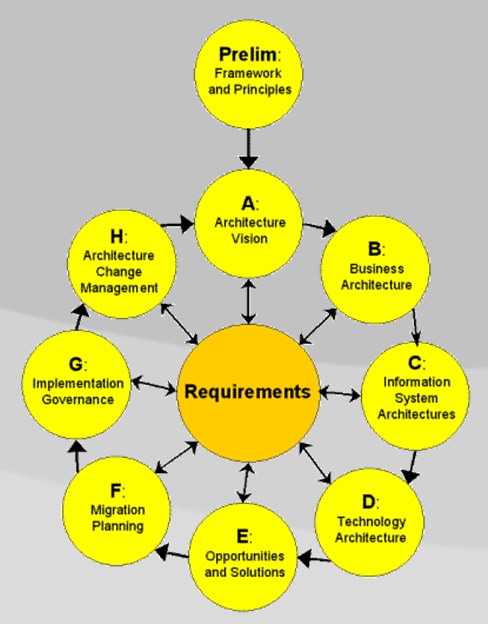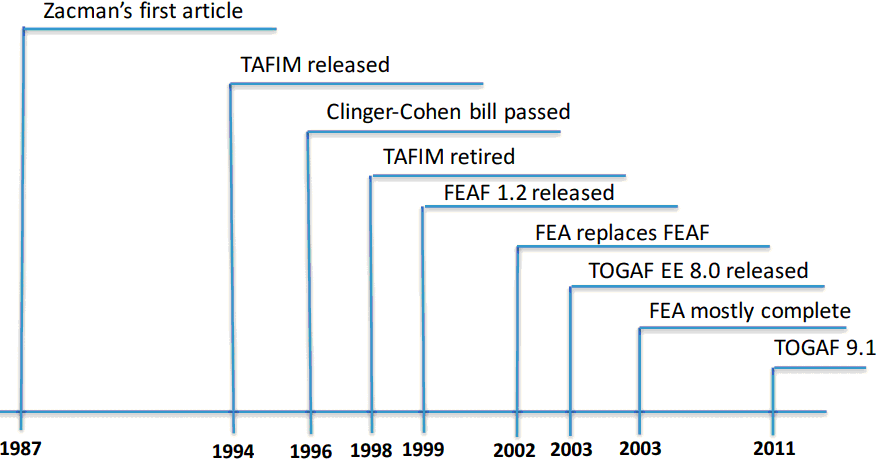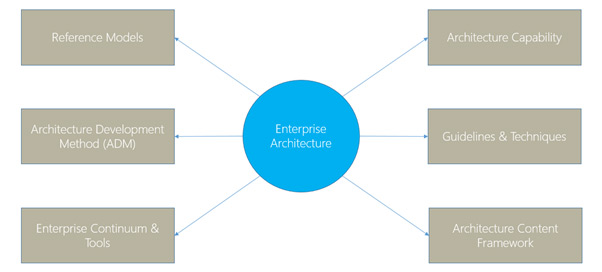A Brief History of Enterprise Architecture
(From Arnab Chattopadhaya 's Enterprise Security Architecture)
Enterprise Architectural Methodologies
• Consortia-developed Frameworks
– ISO 19439
– RM-ODP (ITU-T X.901-904)
– TOGAF
• Defense Industry Framework
– DoDAF
– MODAF
– NAF
• Government Framework
– ESAAF
– FEAF
– NIST Enterprise Architecture Model
• Open Source Frameworks
– TRAK
– SABSA
• Proprietary Frameworks
• Zachman Frameworks
• IAF (Capgemini, 1993)
Case Study to Compare Zachman Framework (Taxonomy) with TOFAF
How Zachman Taxonomy can help DreamKart - Summary• Five ways Zachman Taxonomy can help:
– Ensure that every stakeholder's perspective has been considered for every descriptive focal point
– Improve the DreamKart Enterprise Architecture artifacts themselves by sharpening each of their focus points to one particular concern for one particular audience
– Ensure that all of CxO’s business requirements can be traced down to some technical implementation
– Convince Business function of the organization that the technical team isn't planning on building a bunch of useless functionality
– Convince Technology team that the business folks are including IT teams in their planning
What Zachman Taxonomy does not provide
• Does not provide step-by-step process to create new architecture
• Does not provide much help in validating an architecture
• Does not provide help in deciding future architecture
• Inference: Zachman alone would not be sufficient to meet DreamKart’s challenges
TOGAF compliments Zachman
– Zachman tells how to categorize architecture artifacts
– TOGAF gives the process to create them
====================================================================
EA = S (Strategy) + B (Business) + T (Technology)
Technology = Information / Data + Systems / Applications+ Networks / Infrastructure
Core is ADM.
ADM = ARCHITECTURE DEVELOPMENT METHOD


There are four major parts to Enterprise Architecture:
- Business Architecture
- Data or Information Architecture
- Application Architecture
- Technology Architecture
There are six overall elements to TOGAF documentation (see fig):
- Architecture Capability: This element offers guidance to those looking to set up an Enterprise Architecture practice. It offers organizational models and defines roles and responsibilities.
- Architecture Development Method (ADM): The central element to TOGAF. The ADM provides a step-by-step approach to developing an enterprise architecture.
- Guidelines & Techniques: Building on the previous element, this piece helps in adapting and customizing the ADM based on the more specific nature of your business.
- Reference Models: This element offers two architectural reference models, these being the TOGAF Technical Reference Model (TRM), and the Integrated Information Infrastructure Reference Model (III-RM).
- Enterprise Continuum & Tools: This addresses the taxonomies and tools to classify and store the enterprise’s architecture activity output. The Enterprise Continuum offers a view of the Architecture Repository. This view shows the related architectures and their evolution; from generic to specific, from abstract to concrete and from logical to physical.
- Architecture Content Framework: This element outlines the TOGAF content framework.
References:
- Enterprise Security Architecture—A Top-down Approach : Enterprise frameworks, such as Sherwood Applied Business Security Architecture (SABSA), COBIT and The Open Group Architecture Framework (TOGAF), can help achieve this goal of aligning security needs with business needs.









No comments:
Post a Comment